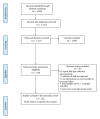Recurrent falls in Parkinson's disease: a systematic review
- PMID: 23533953
- PMCID: PMC3606768
- DOI: 10.1155/2013/906274
Recurrent falls in Parkinson's disease: a systematic review
Abstract
Most people with Parkinson's disease (PD) fall and many experience recurrent falls. The aim of this review was to examine the scope of recurrent falls and to identify factors associated with recurrent fallers. A database search for journal articles which reported prospectively collected information concerning recurrent falls in people with PD identified 22 studies. In these studies, 60.5% (range 35 to 90%) of participants reported at least one fall, with 39% (range 18 to 65%) reporting recurrent falls. Recurrent fallers reported an average of 4.7 to 67.6 falls per person per year (overall average 20.8 falls). Factors associated with recurrent falls include: a positive fall history, increased disease severity and duration, increased motor impairment, treatment with dopamine agonists, increased levodopa dosage, cognitive impairment, fear of falling, freezing of gait, impaired mobility and reduced physical activity. The wide range in the frequency of recurrent falls experienced by people with PD suggests that it would be beneficial to classify recurrent fallers into sub-groups based on fall frequency. Given that there are several factors particularly associated with recurrent falls, fall management and prevention strategies specifically targeting recurrent fallers require urgent evaluation in order to inform clinical practice.
Figures
References
-
- Stolze H, Klebe S, Baecker C, et al. Prevalence of Gait disorders in hospitalized neurological patients. Movement Disorders. 2005;20(1):89–94. - PubMed
-
- Bloem BR, Grimbergen YAM, Cramer M, Willemsen M, Zwinderman AH. Prospective assessment of falls in Parkinson’s disease. Journal of Neurology. 2001;248(11):950–958. - PubMed
-
- Genever RW, Downes TW, Medcalf P. Fracture rates in Parkinson’s disease compared with age- and gender-matched controls: a retrospective cohort study. Age and Ageing. 2005;34(1):21–24. - PubMed
-
- Adkin AL, Frank JS, Jog MS. Fear of falling and postural control in Parkinson’s disease. Movement Disorders. 2003;18(5):496–502. - PubMed
-
- Franchignoni F, Martignoni E, Ferriero G, Pasetti C. Balance and fear of falling in Parkinson’s disease. Parkinsonism and Related Disorders. 2005;11(7):427–433. - PubMed
LinkOut - more resources
Full Text Sources
Other Literature Sources
Medical


